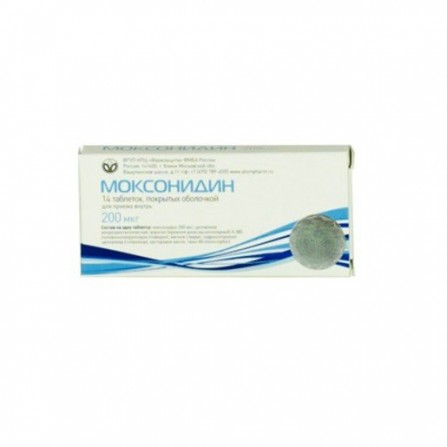Moxonidine film-coated pills 0,2mg N28
Condition: New product
1000 Items
Rating:
Be the first to write a review!

More info
Description
Moxonidine pills reduce insulin resistance.
Active ingredients
Moxonidine
Release form
Pills
Composition
Active ingredient: moxonidine 0.2 mg, Excipients: microcrystalline cellulose, aerosil A-380, polyvinylpyrrolidone, magnesium stearate, hydroxypropylcellulose (clucel), castor oil, tween-80.
Pharmacological effect
Selective imidazoline receptor agonist, responsible for tonic and reflex control over the sympathetic nervous system (localized in the ventro-lateral division of the medulla oblongata). Reduces blood pressure (BP). Slightly associated with central alpha2-adrenorensptorami, due to the interaction with which mediated dry mouth and sedation. Reduces insulin resistance of tissues. Effect on hemodynamics: a decrease in systolic and diastolic blood pressure with a single and prolonged dose of moxonidia is associated with a decrease in the pressor action of the sympathetic system on peripheral vessels, a decrease in peripheral vascular resistance, while cardiac output and heart rate do not change significantly.
Pharmacokinetics
Absorption after ingestion - 90%. Food intake does not affect the amount of absorption. Bioavailability - 88%. Communication with plasma proteins - 7%. Сmax in plasma is determined 30-180 minutes after oral administration and is 1-3 pg / ml. The volume of distribution - 1.4-3 l / kg. It passes through the hemato-encephalic barrier. Not cumulated with prolonged use. The elimination half-life is 2-3 hours. The kidneys are eliminated by 90% (70% - unchanged, 20% - as metabolites). No significant differences in pharmacokinetics in young and elderly patients were found.
Indications
Arterial hypertension.
Contraindications
Hypersensitivity to the components of the drug, sick sinus syndrome, sinoatrial and atrioventricular block II and III, severe bradycardia (heart rate less than 50 beats / min), chronic heart failure III and IV class (according to the NYHA classification), angioedema history, unstable angina, severe liver failure, chronic renal failure (creatinine clearance less than 30 ml / min., creatinine more than 160 μmol / l), age up to 18 years (efficacy and safety e installed), pregnancy and lactation, simultaneous with tricyclic antidepressants.With care: Parkinson’s disease (severe), epilepsy, glaucoma, depression, intermittent claudication, Raynaud’s disease, I degree atrioventricular block, chronic renal failure (creatinine clearance more than 30, but less than 60 ml / min), cerebrovascular diseases, after myocardial infarction, chronic heart failure class I and II, severe hepatic failure due to lack of experience with hemodialysis.
Dosage and administration
Inside, regardless of the meal, squeezed enough liquid. In most cases, the initial dose of moxonidine is 0.2 mg per day, in one step, preferably in the morning. With a lack of therapeutic effect, the dose can be increased after 3 weeks of therapy to 0.4 mg per day in 2 doses or once. The maximum daily dose, which should be divided into 2 doses (morning and evening), is 0.6 mg. The maximum single dose is 0.4 mg. In elderly patients with normal renal function, dosage recommendations are the same as for adult patients. In patients with renal insufficiency (clearance of cretininin 30-60 ml per minute) and patients undergoing hemodialysis, a single dose should not exceed 0.2 mg, the maximum daily dose of 0.4 mg.
Side effects
Especially at the beginning of therapy, the most frequent adverse reactions were: dry mouth, headache, dizziness, asthenia, peripheral edema, allergic reactions, nausea, constipation, drowsiness. The intensity of their manifestation and frequency decrease with repeated intake. Cases of anorexia, pain in the parotid glands, urinary retention or incontinence, dry eye, orthostatic hypotension, Raynaud's syndrome, endocrine disorders, gallstone disease have been reported.
Overdose
Symptoms: headache, sedation, drowsiness, excessively pronounced decrease in blood pressure, dizziness, general weakness, bradycardia, dry mouth, vomiting, fatigue, pain in the stomach. Short-term elevation of blood pressure, tachycardia, and hyperglycemia are also potential. Treatment: symptomatic. Gastric lavage (immediately after ingestion), administration of activated carbon and laxatives, symptomatic therapy.In the case of a decrease in blood pressure, it is recommended to restore the circulating blood volume by administering a liquid. Bradycardia can be stopped by atropine. Alpha-adrenoreceptor antagonists can reduce or eliminate transient hypertension in overdose with moxonidine. As a specific antidote, idazoxane (an imidazoline antagonist) is administered.
Interaction with other drugs
Moxonidine may be administered with thiazide diuretics and “slow” calcium channel blockers. When moxonidine is used together with these and other antihypertensive drugs, there is a mutual reinforcement of the effect of moxonidine. When moxonidine is administered with hydrochlorothiazide, glibenclamide (glyburide), or digoxin, there is no pharmacokinetic interaction. Tricyclic antidepressants can reduce the effectiveness of centrally acting antihypertensive drugs. Beta-adrenergic blockers enhance bradycardia, the severity of the negative in- and dromotropic effects of moxonidine. Moxinidine moderately enhances reduced cognitive ability in patients taking lorazepam. The appointment of moxonidine in conjunction with benzodiazepines may be accompanied by an increase in the sedative effect of the latter. In the appointment of moxonidine together with moclobemide pharmacodynamic interaction is absent.
special instructions
If you need to cancel simultaneously taken beta-blockers and moxonidine, first cancel beta-blockers and, only a few days later, moxonidine. It is not recommended to prescribe tricyclic antidepressants simultaneously with moxonidine. During treatment eliminated the use of alcohol. During treatment, regular monitoring of blood pressure, heart rate and ECG is necessary. Moxonidine can be administered with thiazide diuretics, ACE inhibitors and blockers of “slow” calcium channels. Moxonidine should be discontinued gradually.


